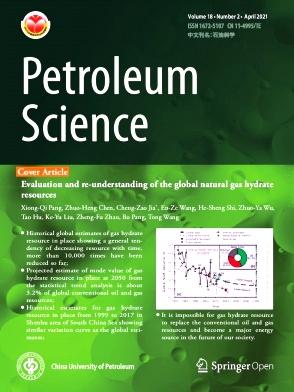Biological origin and depositional environment of crude oils in the Qiongdongnan Basin: Insights from molecular biomarkers and whole oil carbon isotope
IF 6
1区 工程技术
Q2 ENERGY & FUELS
引用次数: 0
Abstract
Molecular biomarker and whole oil carbon isotope (δ13Coil) analyses were conducted on eleven typical crude oils from the Qiongdongnan Basin to investigate their biological sources and depositional environments. Saturated hydrocarbon biomarkers in most samples are characterized by angiosperm-derived compounds, with aromatic compounds dominated by the naphthalene, phenanthrene, biphenyl, and fluorene series. The related source rocks of these oils were mainly deposited under oxic condition, but a subanoxic–suboxic and enclosed water column condition in the Central Depression during Oligocene. The identification of simonellite and related compounds in the aromatic fractions provides reliable evidence for the input of coniferous gymnosperms. Cadalene may also have a potential association with gymnosperms since it shows a strong positive correlation with simonellite. Evidence from density, n-alkanes, short-chain alkylbenzenes and secondary brine inclusions indicates that the unique crude oil B13-1 may have suffered from thermal alteration. These crude oils (excluding B13-1) can be classified into four types based on the δ13Coil values and molecular biomarkers. Type A oil (solely S34-3) is characterized by non-angiosperm plants, with minor dinoflagellates and increasing contribution from conifer gymnosperms than others. Type B oils (L17-2, L18-1, L25-1, and L25-1W) show heavy δ13Coil (−24 ‰ to −25 ‰) and mixed contributions from both angiosperms and marine algae, with the marine algae contribution increasing. Type C oils (L13-2 and B21-1) share similar biological sources with Type B, but the moderately δ13Coil (−25‰ to −26‰) and high level of terrestrial biomarkers suggesting a predominant contribution of angiosperms. Type D oils (Y13-1a, Y13-1b, and Y13-4) possess the lightest δ13Coil (mainly below −26‰) and are primarily derived from angiosperms, with mangrove vegetation playing an important role. Spearman correlation analysis among 14 source biomarker parameters with δ13Coil and geological setting of related source rocks implied that the marine algae should be responsible for the heavy δ13Coil in the Type B. The contribution of marine algae in the Central Depression may have been neglected in the past, as it is usually covered by remarkable angiosperm biomarkers.
琼东南盆地原油的生物起源与沉积环境:分子生物标志物和全油碳同位素的启示
对琼东南盆地十一种典型原油进行了分子生物标记和全油碳同位素(δ13Coil)分析,以研究其生物来源和沉积环境。大多数样本中的饱和碳氢化合物生物标志物以被子植物衍生化合物为特征,芳香族化合物以萘、菲、联苯和芴系列为主。这些油类的相关源岩主要沉积在缺氧条件下,但在渐新世时期的中央洼地却处于亚缺氧-亚缺氧和封闭水柱条件下。在芳香馏分中鉴定出西蒙尼烯和相关化合物,为针叶裸子植物的输入提供了可靠的证据。卡达烯也可能与裸子植物有关,因为它与西蒙尼烯有很强的正相关性。密度、正烷烃、短链烷基苯和二次盐水包裹体的证据表明,独特的原油 B13-1 可能遭受过热蚀变。根据δ13Coil 值和分子生物标记,这些原油(不包括 B13-1)可分为四种类型。A 类油(仅有 S34-3)的特点是由非灌木植物组成,含有少量双鞭毛藻,针叶裸子植物的成分比其他植物多。B 类油(L17-2、L18-1、L25-1 和 L25-1W)的δ13Coil(-24 ‰ 至 -25 ‰)含量较高,被子植物和海洋藻类的含量参差不齐,其中海洋藻类的含量有所增加。C 类油(L13-2 和 B21-1)与 B 类油的生物来源相似,但δ13Coil(-25‰至-26‰)适中,陆生生物标记物含量较高,表明被子植物的贡献占主导地位。D 类油(Y13-1a、Y13-1b 和 Y13-4)的 δ13Coil 最轻(主要低于 -26‰),主要来自被子植物,红树林植被在其中发挥了重要作用。14 个源生物标志物参数与δ13Coil 及相关源岩地质环境的 Spearman 相关性分析表明,B 型的重δ13Coil 应该是海洋藻类造成的。
本文章由计算机程序翻译,如有差异,请以英文原文为准。
求助全文
约1分钟内获得全文
求助全文
来源期刊

Petroleum Science
地学-地球化学与地球物理
CiteScore
7.70
自引率
16.10%
发文量
311
审稿时长
63 days
期刊介绍:
Petroleum Science is the only English journal in China on petroleum science and technology that is intended for professionals engaged in petroleum science research and technical applications all over the world, as well as the managerial personnel of oil companies. It covers petroleum geology, petroleum geophysics, petroleum engineering, petrochemistry & chemical engineering, petroleum mechanics, and economic management. It aims to introduce the latest results in oil industry research in China, promote cooperation in petroleum science research between China and the rest of the world, and build a bridge for scientific communication between China and the world.
 求助内容:
求助内容: 应助结果提醒方式:
应助结果提醒方式:


